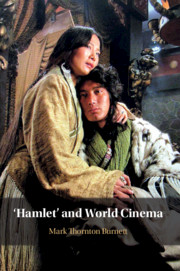Book contents
- ‘Hamlet’ and World Cinema
- ‘Hamlet’ and World Cinema
- Copyright page
- Dedication
- Contents
- Figures
- Acknowledgements
- A note on texts and titles
- Introduction
- Chapter One Hamlet, Cinema and the Histories of Western Europe
- Chapter Two Thematizing Place: Hamlet, Cinema and Africa
- Chapter Three Hamlet and the Moment of Brazilian Cinema
- Chapter Four Pairing the Cinematic Prince: Hamlet, China and Japan
- Chapter Five Hamlet and Indian Cinemas: Regional Paradigms
- Chapter Six Gendering Borders: Hamlet and the Cinemas of Turkey and Iran
- Chapter Seven Materializing Hamlet in the Cinemas of Russia, Central and Eastern Europe
- Filmography
- Bibliography
- Index
Chapter Six - Gendering Borders: Hamlet and the Cinemas of Turkey and Iran
Published online by Cambridge University Press: 21 June 2019
- ‘Hamlet’ and World Cinema
- ‘Hamlet’ and World Cinema
- Copyright page
- Dedication
- Contents
- Figures
- Acknowledgements
- A note on texts and titles
- Introduction
- Chapter One Hamlet, Cinema and the Histories of Western Europe
- Chapter Two Thematizing Place: Hamlet, Cinema and Africa
- Chapter Three Hamlet and the Moment of Brazilian Cinema
- Chapter Four Pairing the Cinematic Prince: Hamlet, China and Japan
- Chapter Five Hamlet and Indian Cinemas: Regional Paradigms
- Chapter Six Gendering Borders: Hamlet and the Cinemas of Turkey and Iran
- Chapter Seven Materializing Hamlet in the Cinemas of Russia, Central and Eastern Europe
- Filmography
- Bibliography
- Index
Summary
The first section argues that İntikam Meleği and Tardid are distinguished by elaborating different constructions of the Old Hamlet/Ghost figure, which is foregrounded in such a way as to address ideas about the execution of justice, the mission of the Hamletian protagonist and the status of the image. Acknowledging the adaptive process entails a corresponding focus on issues of performance. In the second section, I unpick the political valences of both films’ immersion in performance idioms, identifying the significations of the play-within-the-play in İntikam Meleği and the coded ways in which metaphors of water in Tardid, and Siavash/Hamlet’s photojournalism, intimate resistant ideologies. Even as İntikam Meleği and Tardid conjure expectations about the trajectory of the play, I maintain, they also subject them to scrutiny and reversal. This is nowhere more obvious than in both films’ privileging, via casting or rewriting, of women’s roles: İntikam Meleği’s dynamic female Hamlet, for example, is matched by an equivalently pro-active Mahtab/Ophelia in Tardid, who is granted an agency beyond the constrictions of her Shakespearean equivalent.
- Type
- Chapter
- Information
- 'Hamlet' and World Cinema , pp. 188 - 218Publisher: Cambridge University PressPrint publication year: 2019

